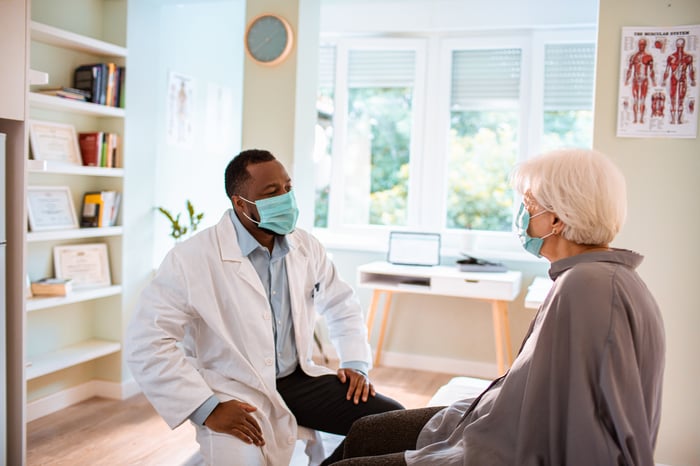Late last month, Japan's Ministry of Health, Labour, and Welfare (MHLW) approved AstraZeneca's (AZN 0.39%) diabetes and heart failure drug, Forxiga (known as Farxiga in the United States), to treat patients with chronic kidney disease, or CKD. This made Forxiga became the first approved medicine for the treatment of CKD in Japan. The news came just weeks after Forxiga was approved for the same indication in the EU.
Let's revisit the results that prompted the MHLW to become the latest regulatory agency to approve Forxiga to treat CKD, as well as the revenue that this new indication could generate for AstraZeneca in Japan.

Image source: Getty Images.
An effective drug to combat a deadly disease
Before outlining the efficacy of Forxiga in treating CKD, it would be useful to first discuss what CKD is and the stages of the disease.
CKD is a condition that impacts the kidneys' ability to filter waste out of the blood, which is a vital bodily function. The most widely used measure of kidney function is the estimated glomerular filtration rate (eGFR), which is based on the levels of creatinine (a waste product) in a patient's blood. The more creatinine in someone's blood, the lower their eGFR, which is an indication that a patient's kidneys are ineffective and/or are working overtime to do their job.
According to the American Kidney Fund, Stage 1 CKD is when a patient has a normal eGFR (90% or higher), but there are other signs of kidney damage such as physical damage or protein in the urine. Stage 2 CKD is expressed by an eGFR between 60% and 89%. Stage 3 CKD is indicated by an eGFR of 30% to 59%. Stage 4 CKD is the last stage before kidney failure and implies moderate to severe kidney damage, which is expressed by an eGFR between 15% and 29%. Stage 5 is the final stage of CKD, when the kidneys have already failed or are close to failing, and is indicated by an eGFR of less than 15%.
The disease's asymptomatic nature throughout most of its progression (up to 90% of patients are unaware that they have CKD) helps make it a relatively deadly condition; in 2017, it was the 12th leading cause of death in the world at an estimated 1.23 million fatalities. This prompted Dr. Theo Vos of the Institute for Health Metrics and Evaluation to label CKD as a "global killer hidden in plain sight."
This is also what makes it especially critical to detect and treat CKD early in the progression of disease to improve health outcomes, which is where Forxiga can potentially help.
The standard-of-care treatment for CKD is an angiotensin-converting enzyme (ACE) inhibitor, which reduces blood pressure to lower the risk of disease progression. Forxiga in combination with an ACE inhibitor was found to lower the relative risk of worsening kidney function, the onset of Stage 5 CKD, and renal death by 39% compared with a combination of an ACE inhibitor with placebo. In addition, the relative risk of death from any cause in CKD patients was demonstrated to be 31% lower among those receiving an ACE inhibitor and Forxiga pairing compared with the ACE inhibitor and placebo combination.
Given Forxiga's usefulness in treating CKD along with a standard-of-care ACE inhibitor, it isn't surprising that the MHLW approved the new indication.
Forxiga gains access to another game-changing market
There are an estimated 13 million people living with CKD in Japan. It's likely that upward of 90% of those individuals aren't aware of their condition, which means that just 1.3 million patients have been diagnosed; to this point, there had been no approved medications to specifically treat CKD in Japan.
Even conservatively assuming that only 20% of those patients formally diagnosed with CKD in Japan start treatment with Forxiga (that number could be higher, given that it's the only approved drug for the condition in that country), that would equate to 260,000 patients.
Adjusting Farxiga's annual list price of about $6,000 in the U.S. to reflect the fact that medications in Japan were on average 43% cheaper in 2017, we'll assume that the average annual net price per patient with insurance adjustments is $2,000.
Among the market of 260,000 CKD patients that Forxiga should be able to capture, this would work out to $520 million in annual revenue potential within the next couple of years as the drug becomes favored by doctors and CKD patients in Japan.
Even in the context of the $36 billion in total revenue analysts are expecting from AstraZeneca for this year, Forxiga's new indication in Japan appears as though it will be a meaningful contributor to revenue in the years ahead.
AstraZeneca is a growth and value hybrid pick
Forxiga's momentum -- its first-half revenue has grown from approximately $850 million last year to $1.36 billion this year -- is poised to continue with the recent regulatory approvals of the drug for CKD in the EU and Japan. And AstraZeneca's acquisition of Alexion Pharmaceuticals arguably forged a best-in-class orphan drug portfolio. Overall, analysts expect the company to generate 20%-plus annual earnings-per-share growth over the next five years.
Especially given AstraZeneca's price-to-earnings ratio of less than 17 for this year (analysts are estimating $3.52 in EPS), this pharma stock provides investors with growth at a fair price.





